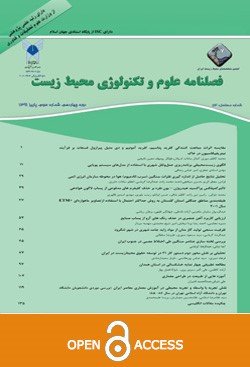Main Factors Affecting Personal Spaces’ Desirability in the Educational Environments
(Case study: Faculty of Architecture and Urban Design)
Subject Areas :
Architecture and urbanism
Hamidreza Azemati
1
 ,
Somayeh Pourbagher
2
,
Mona Mohammadi
3
,
Somayeh Pourbagher
2
,
Mona Mohammadi
3
1 - Associate Professor, Faculty of Architecture and Urbanism Engineering, Shahid Rajaee Teacher Training University, Tehran. Iran*(Corresponding Author).
2 - Ph.D Student, Faculty of Architecture and Urbanism Engineering, Shahid Rajaee Teacher Training University, Tehran. Iran
3 - Master of Architecture, Faculty of Architecture and Urbanism Engineering, Shahid Rajaee Teacher Training University, Tehran. Iran.
Received: 2016-04-27
Accepted : 2016-06-22
Published : 2017-12-22
Keywords:
Architectural design,
Boundaries,
Educational Environments,
Private Space,
Abstract :
Background and Objective: After accomplishment of a survey on universities the results showed that there are many specific problem such as lack of private space and sense of belonging. The aim of this article is studying the theories andconcepts in the area of private space. Method: This study is practical, based on its purpose will give design solutions to improve the quality of private spaces. This research is a mixed study (quality and quantity). For data collection is used literature review and interviews with Experts in this field. These data are firstly analyzed and classified, then measurements were done to find out the importance of the parameters. Questionnaire was made and distributed among a group of specialist including architecture professors and psychologists and then the main questionnaire was conducted and then studied by 48 architecture students. Data analyzing was done by using the Delphi technique and the SPSS software. Findings: At the end, the main influential factors in private spaces were extracted as: the individualization of the area, figuring out how to break down these areas, create semiprivate and quiet spaces. Discussion and Conclusion: Applying these extracted factors will have positive effects on utility of private spaces and improvement quality of learning environments.
References:
Canter, D. (1997); The Facets of place in G T Moore & R W Marans (eds) Advances in Environment, Behavior, and Design. 4. New York. Plenum. Pp 109
JavanForuzandeh, Ali and Motallebi, Ghasem (2011), conception of locational sense and its constitutional factors: urban identity journal, vol., 5, no. 8.(In Persian)
Ansari,Mojtaba; Jamshidi,Samabeh; Almasifar, Tina (2010), investigating sense of region and regional behaviors in urban parks (case study: Saaee park) : Arman Shahr architecture and urban planning journal, Volume 3, Number 4,pp 33-48(Persian language)
Motallebi, Ghasem (2001), environmental psychology as new knowledge in architecture service and urban designing:Honarhaye Ziba journal, no. 10.(In Persian)
Azemati hamidreza, Aminifar zinat, Pourbagher somayeh (2016). Spatial layout pattern of new schools based on the principles of Islamic schools to promote students learning. Naqshejahan 6 (2), 16-23(In Persian)
Azemati, Saeed (2012), academic space deigning by emphasis on outdoors desirability: Master thesis, ShahidRajaei University. P 19(Persian language(
Falahat, Mohammad Sadegh (2006), conception of locational sense and its constitutional factors, HonarhayeZiba journal, 26, summer (In Persian)
Pourbagher Somayeh (2014), Recognition of Physical factors affecting student’s satisfaction in Learning Spaces(Case study:High school in Tehran): MA thesis, ShahidRaja University. (Persian language)
Madanipour, Ali (2012), public spaces and urban private space, FarshadNurian (translator)
Crowe, Sarah (2011). Get Back! The Use of Personal Space Among College Students Journal of Interdisciplinary Undergraduate Research, Vol. 3 [2011], Art
Mohammadi mona (2015), Designing University Educational Spaces with emphasizing on the Utility of Personal Spaces: MA thesis, ShahidRaja University (In Persian)
Moghaddam, F.M. (1998). Social psychology: Exploring universals across cultures. New York, NY: W.H. Freeman & Company. (In Persian)
Bell, P., Green, T., Fisher, J., & Baum, A. (1996). Environmental Psychology (4th edition.). Fort Worth:Harcourt Brace College Publishers
Uzzell, D., & Horne, N. (2006). The influence of biological sex, sexuality and gender role on interpersonal distance. British Journal of Social Psychology, 45, 579–597.
Tanner, C. K. (2006). Effects of the school’s physical environment on student achievement. Educational Planning, 15(2), 25–44.
Musa Zadeh, Ebrahim and Mostafizadeh, Fahim (1391). A look at the concept and foundations of the right to privacy in the customary legal system. Journal of Public Law Knowledge, Year 1, Issue 2. (In Persian)
Ivanovic, Glen Wash (2013). People as place-making coordinate: A methodology for visualizing personal spaces; Frontiers of Architectural Research (2014) 3:36–43.
_||_
Canter, D. (1997); The Facets of place in G T Moore & R W Marans (eds) Advances in Environment, Behavior, and Design. 4. New York. Plenum. Pp 109
JavanForuzandeh, Ali and Motallebi, Ghasem (2011), conception of locational sense and its constitutional factors: urban identity journal, vol., 5, no. 8.(In Persian)
Ansari,Mojtaba; Jamshidi,Samabeh; Almasifar, Tina (2010), investigating sense of region and regional behaviors in urban parks (case study: Saaee park) : Arman Shahr architecture and urban planning journal, Volume 3, Number 4,pp 33-48(Persian language)
Motallebi, Ghasem (2001), environmental psychology as new knowledge in architecture service and urban designing:Honarhaye Ziba journal, no. 10.(In Persian)
Azemati hamidreza, Aminifar zinat, Pourbagher somayeh (2016). Spatial layout pattern of new schools based on the principles of Islamic schools to promote students learning. Naqshejahan 6 (2), 16-23(In Persian)
Azemati, Saeed (2012), academic space deigning by emphasis on outdoors desirability: Master thesis, ShahidRajaei University. P 19(Persian language(
Falahat, Mohammad Sadegh (2006), conception of locational sense and its constitutional factors, HonarhayeZiba journal, 26, summer (In Persian)
Pourbagher Somayeh (2014), Recognition of Physical factors affecting student’s satisfaction in Learning Spaces(Case study:High school in Tehran): MA thesis, ShahidRaja University. (Persian language)
Madanipour, Ali (2012), public spaces and urban private space, FarshadNurian (translator)
Crowe, Sarah (2011). Get Back! The Use of Personal Space Among College Students Journal of Interdisciplinary Undergraduate Research, Vol. 3 [2011], Art
Mohammadi mona (2015), Designing University Educational Spaces with emphasizing on the Utility of Personal Spaces: MA thesis, ShahidRaja University (In Persian)
Moghaddam, F.M. (1998). Social psychology: Exploring universals across cultures. New York, NY: W.H. Freeman & Company. (In Persian)
Bell, P., Green, T., Fisher, J., & Baum, A. (1996). Environmental Psychology (4th edition.). Fort Worth:Harcourt Brace College Publishers
Uzzell, D., & Horne, N. (2006). The influence of biological sex, sexuality and gender role on interpersonal distance. British Journal of Social Psychology, 45, 579–597.
Tanner, C. K. (2006). Effects of the school’s physical environment on student achievement. Educational Planning, 15(2), 25–44.
Musa Zadeh, Ebrahim and Mostafizadeh, Fahim (1391). A look at the concept and foundations of the right to privacy in the customary legal system. Journal of Public Law Knowledge, Year 1, Issue 2. (In Persian)
Ivanovic, Glen Wash (2013). People as place-making coordinate: A methodology for visualizing personal spaces; Frontiers of Architectural Research (2014) 3:36–43.
![]() ,
Somayeh Pourbagher
2
,
Mona Mohammadi
3
,
Somayeh Pourbagher
2
,
Mona Mohammadi
3


